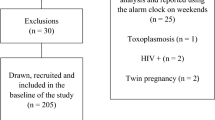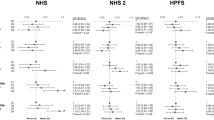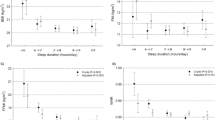Abstract
Background/Objective:
Reduced sleep is a strong and independent risk factor for weight gain and obesity. Maternal obesity preconception and throughout gestation can increase the risk of adverse pregnancy outcomes and impact on offspring health in later life. This study investigated the relationship between sleeping behaviour and macronutrient intake in childbearing aged women.
Subjects/Methods:
We used cross-sectional data from the Australian Longitudinal Study on Women’s Health 1973–78 cohort, aged 31–36 years in 2009 (n=8200). Subjective sleeping behaviour was reported and macronutrient intake was measured using a validated food frequency questionnaire. Latent class analysis (LCA) was used to derive sleeping patterns. Multivariate regression analysis was used to investigate the relationships between sleep and macronutrient intake.
Results:
LCA identified three sleep patterns: (LC1) average sleep (~8 h) with no adverse sleep-related symptoms (n=3570); (LC2) average sleep (~8 h) with sleeping difficulties and severe tiredness (n=2109); and (LC3) short sleep (~6 h) with sleeping difficulties and severe tiredness (n=915). In fully adjusted models, LC2 was inversely associated with percentage energy as protein (b=−0.24; P=0.01) and the protein-to-carbohydrate ratio (b=−0.01; P<0.05). LC3 was positively associated with percentage of energy as fat (b=0.29; P=0.01), saturated fat (b=0.24; P=<0.001) and monounsaturated fat (b=0.09; P=0.04).
Conclusions:
Sleeping behaviour patterns were associated with macronutrient intake in childbearing aged women. Improved sleep patterns, together with diet and physical activity strategies, may make it easier for women to achieve a balanced diet and optimise their weight status in preparation for pregnancy.
This is a preview of subscription content, access via your institution
Access options
Subscribe to this journal
Receive 12 print issues and online access
$259.00 per year
only $21.58 per issue
Buy this article
- Purchase on Springer Link
- Instant access to full article PDF
Prices may be subject to local taxes which are calculated during checkout
Similar content being viewed by others
References
World Health Organisation. Obesity and overweight (Fact sheet No.311) 2015 (cited 11 November 2015). Available from http://www.who.int/mediacentre/factsheets/fs311/en/.
Blumfield ML, Hure AJ, MacDonald-Wicks LK, Smith R, Simpson SJ, Giles WB et al. Dietary balance during pregnancy is associated with fetal adiposity and fat distribution. Am J Clin Nutr 2012; 36: 1032–1041.
Singhal A, Wells J, Cole TJ, Fewtrell M, Lucas A . Programming of lean body mass: a link between birth weight, obesity, and cardiovascular disease. Am J Clin Nutr 2003; 77: 726–730.
Catalano P, Ehrenberg H . Review article: The short- and long-term implications of maternal obesity on the mother and her offspring. Int J Gynaecol Obstet 2006; 113: 1126–1133.
Nelson S, Matthews P, Poston L . Maternal metabolism and obesity: modifiable determinants of pregnancy outcome. Hum Reprod Update 2009; 16: 255–275.
Bhattacharya S, Campbell DM, Liston WA, Bhattacharya S . Effect of body mass index on pregnancy outcomes in nulliparous women delivering singleton babies. BMC Public Health 2007; 7: 1–8.
Rooney BL, Schauberger CW . Excess pregnancy weight gain and long‐term obesity: one decade later. Obstet Gynecol 2002; 100: 245–252.
Rasmussen KM Yaktine AL (eds). Weight Gain During Pregnancy: Re-examining the Guidelines. National Academies Press: Washington, DC, USA, 2009.
Cappuccio FP, Taggart FM, Kandala N, Currie A, Peile E, Stranges S et al. Meta-analysis of short sleep duration and obesity in children and adults. Sleep 2008; 31: 619–626.
Chaput J-P . Sleep patterns, diet quality and energy balance. Physiol Behav 2014; 134: 86–91.
Okun ML, Cussons- Read ME . Sleep disruption during pregnancy: how does it influence serum cytokines? J Reprod Immunol 2007; 73: 158–165.
Barte J, Ter Bogt N, Bogers R, Teixeira P, Blissmer B, Mori T et al. Maintenance of weight loss after lifestyle interventions for overweight and obesity, a systematic review. Obesity Rev 2010; 11: 899–906.
Pandey S, Pandey S, Maheshwari A, Bhattacharya S . The impact of female obesity on the outcome of fertility treatment. J Hum Reprod Sci 2010; 3: 62.
Glazer NL, Hendrickson AF, Schellenbaum GD, Mueller BA . Weight change and the risk of gestational diabetes in obese women. Epidemiology 2004; 15: 733–737.
Wing RR, Lang W, Wadden TA, Safford M, Knowler WC, Bertoni AG et al. Benefits of modest weight loss in improving cardiovascular risk factors in overweight and obese individuals with type 2 diabetes. Diabetes Care 2011; 34: 1481–1486.
Thomson CA, Morrow KL, Flatt SW, Wertheim BC, Perfect MM, Ravia JJ et al. Relationship between sleep quality and quantity and weight loss in women participating in a weight‐loss intervention trial. Obesity 2012; 20: 1419–1425.
Bosy-Westphal A, Hinrichs S, Jauch-Chara K, Hitze B, Later W, Wilms B et al. Influence of partial sleep deprivation on energy balance and insulin sensitivity in healthy women. Obes Facts 2008; 1: 266–273.
Dashti HS, Follis JL, Smith CE, Tanaka T, Cade BE, Gottlieb DJ et al. Habitual sleep duration is associated with BMI and macronutrient intake and may be modified by CLOCK genetic variants. Am J Clin Nutr 2015; 101: 135–143.
Grandner MA, Jackson N, Gerstner JR, Knutson KL . Dietary nutrients associated with short and long sleep duration. Data from a nationally representative sample. Appetite 2013; 64: 71–80.
Haghighatdoost F, Karimi G, Esmaillzadeh A, Azadbakht L . Sleep deprivation is associated with lower diet quality indices and higher rate of general and central obesity among young female students in Iran. Nutrition 2012; 28: 1146–1150.
Brown WJ, Bryson L, Byles BE, Dobson AJ, Lee C, Mishra G et al. Women's health Australia: recruitment for a national longitudinal cohort study. Womens Health 1998; 28: 23–40.
Brown WJ, Bryson L, Dobson AJ, Manderson L, Schofield M, Williams G . Women's health Australia: establishment of the Australian Longitudinal Study on Women's Health. J Womens Health 1996; 5: 467–472.
Lee C, Dobson AJ, Brown WJ, Bryson L, Byles J, Warner-Smith P et al. Cohort profile: the Australian Longitudinal Study on Women’s Health. Int J Epidemiol 2005; 34: 987–991.
Hodge A, Patterson AJ, Brown WJ, Ireland P, Giles G . The Anti Cancer Council of Victoria FFQ: relative validity of nutrient intakes compared with weighed food records in young to middle‐aged women in a study of iron supplementation. Aust NZ J Public Health 2000; 24: 576–583.
Cappuccio FP, D'Elia L, Strazzullo P, Miller MA . Quantity and Quality of Sleep and Incidence of Type 2 Diabetes A systematic review and meta-analysis. Diabetes Care 2010; 33: 414–420.
Meltzer HM, Brantsaeter AL, Ydersbond TA, Alexander J, Haugen M . Methodological challenges when monitoring the diet of pregnant women in a large study: experiences from the Norwegian Mother and Child Cohort Study (MoBa). Matern Child Nutr 2008; 4: 14–27.
Food Standards Australia New Zealand Explanatory Notes: for Use With NUTTAB 2006 Online Version and NUTTAB 2006 Electronic Release. Australian Government Publishing Service: Canberra, ACT, Australia, 2007.
Lo Y, Mendell NR, Rubin DB . Testing the number of componsents in a normal mixture. Biometrika 2001; 88: 767–778.
Rubin DB . Multiple imputation after 18 years. J Am Stat Assoc 1996; 91: 389–473.
Maldonado G, Greenland S . Simulation study of confounder-selection strategies. Am J Epidemiol 1993; 138: 923–936.
Buxton OM, Cain SW, O'Connor SP, Porter JH, Duffy JF, Wang W et al. Metabolic consequences in humans of prolonged sleep restriction combined with circadian disruption. Sci Transl Med 2012; 4: 129ra43.
Cain SW, Filtness AJ, Phillips CL, Anderson C . Enhanced preference for high-fat foods following a simulated night shift. Scand J Work Environ Health 2015; 41: 288–293.
Baglioni C, Battagliese G, Feige B, Spiegelhalder K, Nissen C, Voderholzer U et al. Insomnia as predictor of depression: A meta-analytic evaluation of longditudinal epidemiological studies. J Affect Disord 2011; 135: 10–19.
McLean C, Asnaani A, Litz B, Hoffmann S . Gender differences in anxiety disorders: Prevalence, course of illness, comorbidity and burden of illness. J Psychiat Res 2011; 45: 1027–1035.
Alvaro P, Roberts A, Harris J . A systematic review assessing bidirectionality between sleep disturbance, anxiety and depression. Sleep 2013; 36: 1059–1068.
Grandner M, Kripke D, Naidoo N, Langer R . Relationships among dietary nutrients and subjective sleep, objective sleep, and napping in women. Sleep Med 2010; 11: 180–184.
Kennedy A, Martinez K, Chuang C-C, LaPoint K, McIntosh M . Saturated fatty acid-mediated inflammation and insulin resistance in adipose tissue: mechanisms of action and implications. J Nutr 2009; 139: 1–4.
Gregor M, Hotamisligil G . Inflammatory mechanisms in obesity. Annu Rev Immunol 2011; 29: 415–445.
Lumeng CN, Saltiel AR . Inflammatory links between obesity and metabolic disease. J Clin Invest 2011; 121: 2111–2118.
Australian Bureau of Statistics Australian Health Survey: Nutrition First Results—Food and nutrients 2011-2012. Commonwealth of Australia: Canberra, ACT, Australia, 2014.
Challis J, Lockwood C, Myatt L, Norman J, Strauss J, Petraglia F . Inflammation and pregnancy. Reprod Sci 2009; 16: 206–215.
Hotamisligil G . Inflammation and metabolic disorders. Nature 2006; 444: 860–867.
Van Den Burg J, Van Roojj F, Vos H, Tulen J, Hoffman A, Miedema A et al. Disagreement between subjective and actigraphic measures of sleep duration in a population-based study of elderly persons. J Sleep Res 2008; 17: 295–302.
Acknowledgements
The research on which this paper is based was conducted as part of the Australian Longitudinal Study on Women’s Health, the University of Newcastle and the University of Queensland. We are grateful to the Australian Government Department of Health and Ageing for funding, and to all the women who provided survey data. The authors would also like to thank Professor Graham Giles of the Cancer Epidemiology Centre of Cancer Council Victoria, for permission to use the Dietary Questionnaire for Epidemiological Studies (Version 2), Melbourne: Cancer Council Victoria, 1996. MB and HT designed and supervised conduct of the study. MB conducted the analysis and CB drafted the manuscript under the supervision of all authors. All authors contributed to reviewing, editing, and approving the final version of the paper.
Author information
Authors and Affiliations
Corresponding author
Ethics declarations
Competing interests
The authors declare that they have no conflict of interests.
Rights and permissions
About this article
Cite this article
Bennett, C., Truby, H., Zia, Z. et al. Investigating the relationship between sleep and macronutrient intake in women of childbearing age. Eur J Clin Nutr 71, 712–717 (2017). https://doi.org/10.1038/ejcn.2016.145
Received:
Revised:
Accepted:
Published:
Issue Date:
DOI: https://doi.org/10.1038/ejcn.2016.145



